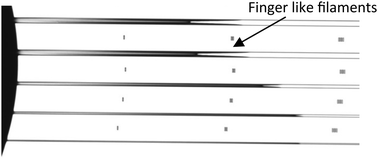Capillary driven flow of polydimethylsiloxane in open rectangular microchannels†
Abstract
The flow of liquid polydimethylsiloxane (PDMS, Dow Corning Sylgard 184, 10 : 1 base to cross-linker ratio) in open, rectangular silicon microchannels, with and without a coating (100 nm) of poly-tetra-fluoro-ethylene (PTFE), was studied. Photolithographic patterning and etching of silicon wafers was used to create microchannels with a range of widths (∼5–50 μm) and depths (5–20 μm). Experimental PDMS flow rates in both PTFE-coated and uncoated channels were compared to an analytical model based on the work of Lucas and Washburn. The experimental flow rates matched the predicted flow rates reasonably well when the channel aspect ratio (width to depth), p, was less than 2. For channels with p > 2, the observed flow rates progressively lagged model predictions with increasing p. The experimental data, including zero flow rates in certain high aspect ratio PTFE-coated channels, can largely be explained by changes in the front and upper meniscus morphology of the flow as the channel aspect ratio is varied. The results strongly suggest that meniscus morphology needs to be taken into account to accurately model capillary flow in microchannels, especially those with large aspect ratios.


 Please wait while we load your content...
Please wait while we load your content...